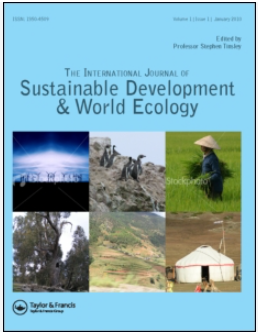基于综合矿业生态指数(CMEI)的矿区环境监测——以内蒙古锡林浩特为例
IF 7.7
3区 环境科学与生态学
Q1 ECOLOGY
International Journal of Sustainable Development and World Ecology
Pub Date : 2023-04-25
DOI:10.1080/13504509.2023.2205835
引用次数: 2
摘要
摘要矿区环境生态状况监测与评价是有效指导矿产管理的关键,而遥感是一种覆盖大空间、高时间频率的经济有效的解决方案。然而,矿区景观的多样性对寻找合适的监测方法提出了挑战。为了应对这一挑战,本研究提出了一种基于遥感的综合采矿生态指数(CMEI),该指数综合了从Landsat图像和MODIS(中分辨率成像光谱仪)产品中获得的植被绿化率、土壤湿度、城市热量、空气质量和水质指标。集成是通过主成分分析(PCA)来封装露天矿区环境的各个方面来实现的。然后将CMEI应用于内蒙古锡林浩特煤田过去20年生态修复项目的绩效评估。研究结果表明,锡林浩特煤田排土场和回填场的整体生态环境得分从2005年的0.15分提高到2020年的0.33分。然而,我们的研究也强调,一些新建立的倾倒场地需要进一步加强管理和维护措施。CMEI为矿区生态环境监测与评价提供了一种新颖有效的方法,可应用于全球露天矿区生态环境评价。本文章由计算机程序翻译,如有差异,请以英文原文为准。
Environment monitoring of mining area with comprehensive mining ecological index (CMEI): a case study in Xilinhot of Inner Mongolia, China
ABSTRACT The monitoring and evaluation of environmental and ecological status in mining area is critical for effective mineral management guidance, and remote sensing is a cost-effective solution for covering a wide spatial area with high temporal frequency. However, the diverse landscape in mining areas presents a challenge for finding a suitable monitoring method. To address this challenge, this study proposes a remote sensing-based comprehensive mining ecological index (CMEI), which integrates vegetation greenness, soil wetness, urban heat, air quality and water quality indicators obtained from Landsat images and Moderate Resolution Imaging Spectroradiometer (MODIS) products. The integration is achieved through a principal component analysis (PCA) to encapsulate various aspects of the environment in opencast mining areas. The proposed CMEI was then applied to assess the performance of an ecological restoration project carried out in the Xilinhot coalfield in Inner Mongolia, China, over the past two decades. Our findings show that the overall ecological environment in the dumping sites and backfilling sites of Xilinhot coalfield has improved from a score of 0.15 in 2005 to 0.33 in 2020, according to the CMEI. Nevertheless, our study also highlights that some newly established dumping sites require further strengthening of management and maintenance measures. The CMEI presents a novel and effective approach for monitoring and evaluating the ecological environment in mining areas, and it can potentially be applied to assess the ecological environment of opencast mining areas globally.
求助全文
通过发布文献求助,成功后即可免费获取论文全文。
去求助
来源期刊
CiteScore
11.10
自引率
3.60%
发文量
58
审稿时长
18-36 weeks
期刊介绍:
The International Journal of Sustainable Development and World Ecology is now over fifteen years old and has proved to be an exciting forum for understanding and advancing our knowledge and implementation of sustainable development.
Sustainable development is now of primary importance as the key to future use and management of finite world resources. It recognises the need for development opportunities while maintaining a balance between these and the environment. As stated by the UN Bruntland Commission in 1987, sustainable development should "meet the needs of the present generation without compromising the ability of future generations to meet their own needs."

 求助内容:
求助内容: 应助结果提醒方式:
应助结果提醒方式:


